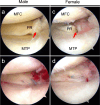Favorable clinical outcomes are achieved in both male and female following medial meniscus posterior root repair
- PMID: 40515764
- PMCID: PMC12167242
- DOI: 10.1007/s00590-025-04344-y
Favorable clinical outcomes are achieved in both male and female following medial meniscus posterior root repair
Abstract
Purpose: In recent years, medial meniscus (MM) posterior root tears (PRT) have received increasing attention due to their association with rapidly progressive knee osteoarthritis. MM posterior root (PR) repair has been reported to yield good clinical outcomes, but no study has yet to compare the postoperative outcomes after MMPR repair between sexes. The purpose of this study is evaluating the postoperative clinical outcomes following MMPR pullout repair by sex.
Methods: Eighty-six patients who underwent pullout repair for isolated MMPRTs at our institution between October 2016 and November 2019 were evaluated. Patients were divided into two groups according to sex, and their clinical outcomes were compared preoperatively and at 2 years postoperatively.
Results: The cohort was comprised of 21 male and 65 female patients. Three factors related to physical status (height (p < 0.01), body weight (p < 0.01), and BMI (p = 0.02)) were significantly higher in male patients. No significant differences were observed in preoperative clinical scores between male and female. All clinical scores significantly improved at 2 years postoperatively in both sexes. In the clinical scores, the KOOS-symptom (p = 0.03), KOOS-QOL (p = 0.03), and Tegner activity scores (p < 0.01) showed significantly better scores in male patients.
Conclusion: Following MMPR pullout repair, the clinical outcomes significantly improved in both sexes. These results indicate that MMPR pullout repair is a universally effective technique regardless of the disadvantages of females in morphological characteristics.
Keywords: Clinical outcome; Medial meniscus; Posterior root tear; Pullout repair; Sex difference.
© 2025. The Author(s).
Conflict of interest statement
Declarations. Conflict of interests: The authors declare that they have no Conflict of interests.
Figures



Similar articles
-
Longitudinal changes in medial meniscus extrusion and clinical outcomes following pullout repair for medial meniscus posterior root tears: a 3-year evaluation.Eur J Orthop Surg Traumatol. 2024 May;34(4):2021-2029. doi: 10.1007/s00590-024-03889-8. Epub 2024 Mar 22. Eur J Orthop Surg Traumatol. 2024. PMID: 38517526 Free PMC article.
-
Signal intensity of repaired posterior roots after transtibial pullout repair for medial meniscus posterior root tears in stable knees: Magnetic resonance imaging evaluations at 3 years postoperatively.Knee. 2024 Jun;48:22-29. doi: 10.1016/j.knee.2024.02.014. Epub 2024 Mar 14. Knee. 2024. PMID: 38484441
-
Clinical effect of medial meniscus posterior root repair combined with centralization technique in the treatment of medial meniscus posterior root tears.BMC Musculoskelet Disord. 2024 Nov 30;25(1):982. doi: 10.1186/s12891-024-08125-2. BMC Musculoskelet Disord. 2024. PMID: 39616323 Free PMC article.
-
Examining the Efficacy of Medial Meniscus Posterior Root Repair: A Meta-analysis and Systematic Review of Biomechanical and Clinical Outcomes.Am J Sports Med. 2023 Jun;51(7):1914-1926. doi: 10.1177/03635465221077271. Epub 2022 Apr 6. Am J Sports Med. 2023. PMID: 35384728
-
A Systematic Review of Adverse Events and Complications After Isolated Posterior Medial Meniscus Root Repairs.Am J Sports Med. 2024 Mar;52(4):1109-1115. doi: 10.1177/03635465231157758. Epub 2023 May 2. Am J Sports Med. 2024. PMID: 37129097
References
-
- Allaire R, Muriuki M, Gilbertson L, Harner CD (2008) Biomechanical consequences of a tear of the posterior root of the medial meniscus. Similar to total meniscectomy. J Bone Joint Surg Am 90:1922–1931. 10.2106/JBJS.G.00748 - PubMed
-
- Krych AJ, Lamba A, Wang AS, Boos AM, Camp CL, Levy BA, Stuart MJ, Hevesi M (2023) Nonoperative management of degenerative medial meniscus posterior root tears: poor outcomes at a minimum 10-year follow-up. Am J Sports Med 51:2603–2607. 10.1177/03635465231185132 - PubMed
-
- Bernard CD, Kennedy NI, Tagliero AJ, Camp CL, Saris DBF, Levy BA, Stuart MJ, Krych AJ (2020) Medial meniscus posterior root tear treatment: a matched cohort comparison of nonoperative management, partial meniscectomy, and repair. Am J Sports Med 48:128–132. 10.1177/0363546519888212 - PubMed
-
- Mochizuki Y, Kawahara K, Samejima Y, Kaneko T, Ikegami H, Musha Y (2021) Short-term results and surgical technique of arthroscopic centralization as an augmentation for medial meniscus extrusion caused by medial meniscus posterior root tear. Eur J Orthop Surg Traumatol 31:1235–1241. 10.1007/s00590-021-02874-9 - PubMed
MeSH terms
Grants and funding
LinkOut - more resources
Full Text Sources
Research Materials

